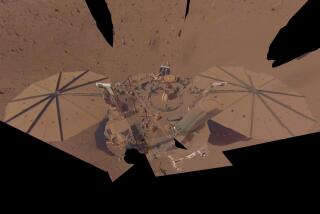New look at Apollo moon rocks reveals signs of ‘native’ water
Scientists picking up signs of water on the moon’s surface typically attribute them to deposits left by comets, asteroids and other heavenly objects. But a new analysis of lunar samples brought back to Earth by Apollo astronauts in the early 1970s indicates that the moon’s interior may have been a little damp in its early days.
The findings, published online Sunday in the journal Nature Geoscience, support mounting evidence that the moon once contained some “native” water — throwing a wrench into current beliefs about how Earth’s companion formed.
Prevailing theories hold that the moon was created when a Mars-sized body crashed into the young Earth and broke off debris that eventually coalesced into a new entity. In the process, much of the water would have evaporated into space, leaving Earth’s new satellite quite arid.
“It’s thought that the moon’s formation involved the materials getting very hot,” said Paul Warren, a UCLA cosmochemist who was not involved in the new study. “It’s usually assumed that little water would have survived through that.”
Indeed, the samples returned by the Apollo missions that visited the lunar highlands seemed to confirm that Earth’s cold, rocky companion was bone-dry, said University of Notre Dame geologist Hejiu Hui, who led the new analysis.
But work in the last five years has challenged that notion, as scientists have used more advanced methods to look for increasingly tiny concentrations of water in glass beads that are thought to have been formed by volcanic eruptions in the moon’s early days.
Some experts have argued that those glass beads could have been exposed to alien water sources after they had been ejected from the moon’s interior. So Hui and his colleagues decided to look at a type of rock called plagioclase, which is thought to have formed in a magma ocean inside the moon. Although the rocks later floated to the surface to form the crust, they contain a chemical time capsule from inside the young moon.
To further rule out any outside source of water, Hui’s team looked past the surface of these rocks and into their centers.
After examining the samples under a microscope equipped with a spectrometer, the researchers found that the rocks contained 6 parts per million of water. That’s drier than an Earth desert, but far more than expected to survive in a rock from the moon’s once-molten center.
The samples should have been bone-dry, Hui said, but “somehow we still detect this amount of water, so that makes things interesting.”
Based on their measurements, the researchers estimated that the early moon’s magma ocean could have contained up to 320 parts per million of water. Once that ocean mostly crystallized, the remaining residues could have had as much as 1.4% water. That could explain the measured water content in lunar rocks, Hui said.
The findings could have interesting implications for theories about how the moon came to be, Warren said.
“It’s thought that the moon’s formation involved the materials getting very hot, and it’s usually assumed that little water would have survived through that,” he said. If the new study is right, “It opens up quite a mystery as to how the moon came through what we think was a very hot genesis process with this much water.”
The findings also have implications for the moon’s geological evolution, Warren said. Researchers have reconstructed the history of the moon’s crustal formation while assuming there were negligible amounts of water involved. Now scientists may need to reevaluate some of those ideas.
Knowing how much water there is could be handy for future explorers. “Someday, when we put men on the moon in a more permanent way, we might need that water,” Warren said.







